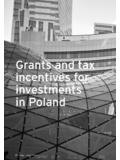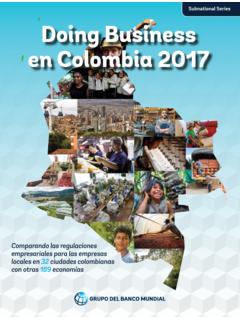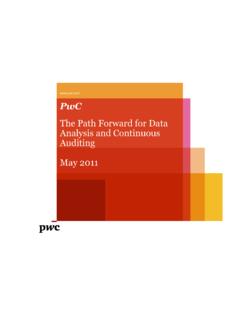Transcription of PISA 2015 - oecd.org
1 PISA 2015. Results in Focus Over the past decade, the OECD Programme for International Student Assessment, PISA, has become the world's premier yardstick for evaluating the quality, equity and efficiency of school systems. By identifying the characteristics of high-performing education systems, PISA allows governments and educators to identify effective policies that they can then adapt to their local contexts. The latest PISA assessment in 2015 focused on science. From taking a painkiller to determining what is a balanced meal, from drinking pasteurised milk to deciding whether or not to buy a hybrid car, science is ubiquitous in our lives. And science is not just test tubes and the periodic table; it is the basis of nearly every tool we use from a simple can opener to the most advanced space explorer. More important, science is not only the domain of scientists. In the context of massive information flows and rapid change, everyone now needs to be able to think like a scientist : to be able to weigh evidence and come to a conclusion.
2 To understand that scientific truth may change over time, as new discoveries are made, and as humans develop a greater understanding of natural forces and of technology's capacities and limitations. This brochure highlights some of the results from PISA 2015. PISA shows that every country has room for improvement, even the top performers. With high levels of youth unemployment, rising inequality, a significant gender gap, and an urgent need to boost inclusive growth in many countries, we have no time to lose in providing the best education possible for all students. Angel Gurr a OECD Secretary-General 2 PISA 2015 Results in Focus OECD 2016. What is PISA? Key features of PISA 2015. What is important for citizens to know and be able to do? Content In response to that question and to the need for internationally The PISA 2015 survey focused on science, with reading, comparable evidence on student performance, the Organisation mathematics and collaborative problem solving as minor for Economic Co-operation and Development (OECD) launched areas of assessment.
3 PISA 2015 also included an assessment the triennial survey of 15-year-old students around the world of young people's financial literacy, which was optional for known as the Programme for International Students Assessment, countries and economies. or PISA. PISA assesses the extent to which 15-year-old students, near the end of their compulsory education, have acquired key Participating students knowledge and skills that are essential for full participation in Approximately 540 000 students completed the assessment in modern societies. The assessment focuses on the core school 2015, representing about 29 million 15-year-olds in the schools subjects of science, reading and mathematics. Students'. of the 72 participating countries and economies. proficiency in an innovative domain is also assessed (in 2015, this domain is collaborative problem solving). The assessment does The assessment not just ascertain whether students can reproduce knowledge; it also examines how well students can extrapolate from what they Computer-based tests were used, with assessments lasting a have learned and can apply that knowledge in unfamiliar settings, total of two hours for each student.
4 Both in and outside of school. This approach reflects the fact that Test items were a mixture of multiple-choice questions and modern economies reward individuals not for what they know, but questions requiring students to construct their own responses. for what they can do with what they know. The items were organised in groups based on a passage PISA is an ongoing programme that offers insights for education setting out a real-life situation. About 810 minutes of test items policy and practice, and that helps monitor trends in students' for science, reading, mathematics and collaborative problem acquisition of knowledge and skills across countries and in solving were covered, with different students taking different different demographic subgroups within each country. PISA combinations of test items. results reveal what is possible in education by showing what Students also answered a background questionnaire, which students in the highest-performing and most rapidly improving took 35 minutes to complete.
5 The questionnaire sought education systems can do. The findings allow policy makers information about the students themselves, their homes, around the world to gauge the knowledge and skills of students and their school and learning experiences. School principals in their own countries in comparison with those in other countries, completed a questionnaire that covered the school system set policy targets against measurable goals achieved by other and the learning environment. For additional information, some education systems, and learn from policies and practices countries/economies decided to distribute a questionnaire applied elsewhere. While PISA cannot identify cause-and-effect to teachers. It was the first time that this optional teacher relationships between policies/practices and student outcomes, questionnaire was offered to PISA-participating countries/. it can show educators, policy makers and the interested public economies.
6 In some countries/economies, optional how education systems are similar and different and what that questionnaires were distributed to parents, who were asked means for students. to provide information on their perceptions of and involvement in their child's school, their support for learning in the home, and their child's career expectations, particularly in science. Countries could choose two other optional questionnaires for students: one asked students about their familiarity with and use of information and communication technologies; and the second sought information about students' education to date, including any interruptions in their schooling, and whether and how they are preparing for a future career. OECD 2016 3. Excellence and equity in education What the data tell us Students' performance in reading and mathematics Students' performance in science and attitudes towards About 20% of students in OECD countries, on average, do not science attain the baseline level of proficiency in reading.
7 This proportion has remained stable since 2009. Singapore outperforms all other participating countries/economies in science. Japan, Estonia, Finland and Canada, in descending On average across OECD countries, the gender gap in reading order of mean science performance, are the four highest- in favour of girls narrowed by 12 points between 2009 and performing OECD countries. 2015: boys' performance improved, particularly among the highest-achieving boys, while girls' performance deteriorated, Some 8% of students across OECD countries (and 24% of particularly among the lowest-achieving girls. students in Singapore) are top performers in science, meaning that they are proficient at Level 5 or 6. Students at these levels More than one in four students in Beijing-Shanghai-Jiangsu- are sufficiently skilled in and knowledgeable about science to Guangdong (China), Hong Kong (China), Singapore and creatively and autonomously apply their knowledge and skills to Chinese Taipei are top-performing students in mathematics, a wide variety of situations, including unfamiliar ones.
8 Meaning that they can handle tasks that require the ability to formulate complex situations mathematically, using symbolic About 20% of students across OECD countries perform below representations. Level 2, considered the baseline level of proficiency in science. At Level 2, students can draw on their knowledge of basic Equity in education science content and procedures to identify an appropriate Canada, Denmark, Estonia, Hong Kong (China) and explanation, interpret data, and identify the question being Macao (China) achieve high levels of performance and equity addressed in a simple experiment. All students should be in education outcomes. expected to attain Level 2 by the time they leave compulsory education. Socio-economically disadvantaged students across OECD. countries are almost three times more likely than advantaged In the majority of countries with comparable data, students'. students not to attain the baseline level of proficiency in science.
9 Performance in science remained essentially unchanged since But about 29% of disadvantaged students are considered 2006. However, mean performance in science improved resilient meaning that they beat the odds and perform at high between 2006 and 2015 in Colombia, Israel, Macao (China), levels. And in Macao (China) and Viet Nam, students facing the Portugal, Qatar and Romania. Over this period, Macao (China), greatest disadvantage on an international scale outperform the Portugal and Qatar increased the share of students performing most advantaged students in about 20 other PISA-participating at or above Level 5 and simultaneously reduced the share of countries and economies. students performing below the baseline level of proficiency (Level 2). While between 2006 and 2015 no country or economy improved its performance in science and equity in education Even though gender differences in science performance tend to simultaneously, the relationship between socio-economic status be small, on average, in 33 countries and economies, the share and student performance weakened in nine countries where of top performers in science is larger among boys than among mean science scores remained stable.
10 The United States shows girls. Finland is the only country in which girls are more likely to the largest improvements in equity during this period. be top performers than boys. On average across OECD countries, and after taking their socio- On average across OECD countries, 25% of boys and 24%. economic status into account, immigrant students are more of girls reported that they expect to work in a science-related than twice as likely as their non-immigrant peers to perform occupation. But boys and girls tend to think of working below the baseline level of proficiency in science. Yet 24% of in different fields of science: girls envisage themselves as disadvantaged immigrant students are considered resilient. health professionals more than boys do; and in almost all countries, boys see themselves as becoming information and On average across countries with relatively large immigrant communications technologies (ICT) professionals, scientists or student populations, attending a school with a high engineers more than girls do.

















